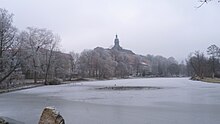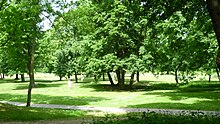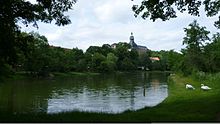Sondershausen Castle Park
The Sondershausen Palace Park , also once known as the “ Princely Park of Sondershausen ”, is a landscape park in Thuringia . The complex is relatively centrally located in the district town of Sondershausen and is quite a large and important work of garden art in relation to the city. The park and Sondershausen Castle , which is characterized by around six different art epochs, form a respectable composition.
Most of it is an English landscape garden of around 30 hectares , which was designed around 1836 by Tobias Philipp Ekart , Carl Eduard Petzold (1815-1891) and Carl Arlt and laid out under their direction. The river Wipper , which flows through the city, was integrated into the park. The system itself can be divided into an upper and a lower area.
history

The beginnings of a park or garden that was laid out around the castle dates back to the middle of the 16th century. At that time there was a renaissance complex that surrounded the castle with pleasure and kitchen gardens. Around 1700 it was converted into a baroque garden based on the French model.
The cradle and center of the lower part of the park was the Lohplatz. Prince Christian Wilhelm von Schwarzburg-Sondershausen (1645–1721) had a pheasantry with a maze built there in 1694 . Around 1700 an avenue from the octagonal house to Lohplatz was laid out with pairs of obelisks . Around 1800 this place was redesigned with a shooting range, a drinking hall and music pavilions. After Carl Scheppig came to Sondershausen, he redesigned the square in 1837 and had the Loh Hall built for the Loh concerts and built a fountain.
The beginning of the landscape garden was made around 1836 by garden inspector Dr. Tobias Philipp Ekart , who had the task of redesigning the swamp meadows, also known as tub meadows, and creating a park in the valley section below the Schlossberg up to the Wipper. The order for this was given by Prince Günther Friedrich Carl II von Schwarzburg-Sondershausen (1801–1889) shortly after he took office. Ekart recorded his plans in the text Consideration on Fine Landscape Garden Art in an explanatory description of the Princely Park in Sondershausen in 1836. Execution began a year later. 13,000 trees were planted and the small park pond dug. But all efforts were wrecked again and again by the floods of the following years.
At that time Petzold also came to Sondershausen and was commissioned with the redesign. Hofgärtner Arlt was in charge of the work. The aim was to give the park a harmonious character through the alternation of light and shadow, caused by open, sunlit meadow areas, room-structuring individual trees, groups of trees and differently sized, closed tree and shrub plantations as well as wide views of the landscape. Artificially created ponds were fed by the man-made Mühlwipper, also called Mühlgraben, which had been branched off from the Wipper near Stockhausen . Many of the lakes and fountains built back then are no longer available today. Only the large and small park ponds can still be found.
After the prince's abdication, voices were raised calling for a gardening and landscaping working group at Sondershausen Castle to manage the park. So this should be used agriculturally. But opponents argued that Sondershausen would lose a special gem forever. The park began to go into neglect. The Second World War with its hail of bombs over Sondershausen on April 8, 1945 and the post-war period under the conditions of the Soviet Zone and GDR did the rest.
Serious repair work was only started in 1991 and is still ongoing today.
The park and its parts
The system includes an old, upper and a newer or lower area.
The older one is located on the castle plateau and dates back to the 16th century and the baroque garden design around 1700. These include the Prinzessinnengarten, the pleasure garden with fountain and the theater meadow, on which the court theater was located until 1946 , the royal stables and the carriage house , the no longer existing riding arena as well as the octagonal house and today's parking areas, where once the 8 April 1945 The bomb-destroyed orangery and the princely greenhouses of the court gardening department stood.
The younger part of the park was created in the course of the redevelopment into a landscape park and contains two lakes, the large and the small park pond , the Wipper and the Mühlwipper with a castle mill, a tea house, a park ranger's house, the pheasantry (now allotments), numerous bridges and decorations. From the castle via Obeliskenallee you get to Lohplatz, where the classical Loh concert hall designed by Scheppig once stood with some music pavilions and today the theater or concert hall "Haus der Kunst" is located as well as the wing of the "Hereditary Prince".
The pleasure garden
The pleasure garden with its extensive lawn is flanked with deciduous trees at four corners and surrounded by a row of chestnuts . In the center there is a large flat bowl from which the fountain of a fountain rises.
During the Renaissance in the middle of the 16th century, the pleasure and kitchen gardens that surrounded the castle were located here.
The complex was converted into a baroque garden around 1700 based on the French model . According to a description of Thuringian parks and gardens by G. Timm, the architectural decoration “was primarily a portal that provided access to the pleasure garden from the palace courtyard. It was decorated with statues by the sculptor Sixtus Grundmann and four pictures [...]. In general, statues, grottos , arbors and lawn benches not only adorned the pleasure garden, but also the avenues in the Lohwäldchen. "
The court theater was also born in the pleasure garden at the beginning of the 19th century. On July 18, 1815, the traveling group of actors Tilly performed the warlike spectacle Walltron von Möller. Prince Günther Friedrich Carl I liked the 16 actors and singers so much that he hired them for a first court theater in the giant hall.
In the years that followed, the complex became increasingly dilapidated and was mainly used as a riding and parade ground, as the prince preferred uniforms and military pomp.
On April 8, 1945, the air raid on Sondershausen transformed the pleasure garden almost all the way to the castle into a crater landscape with deep bomb craters and the loss of valuable trees. The magnificent orangery from 1709 lay in ruins and was never rebuilt.
Today the pleasure garden is a place of rest and relaxation, in which mainly citizens of the city relax with a picnic or sunbathing.
Relics of the historical furnishings in the park
In the Sondershausen Palace Park there are still some relics from the once lavish furnishings, including from the Baroque and Classicism periods. A few examples can be seen here:
Fallen Memorial in the park
The architect Reinhard Erasmus designed a memorial in 1923 for those who fell and went missing in the First World War . It resembles a grandstand with stairs on both sides. There was a sprinkled water basin in front of the monument. Four weathered panels showed the names of the dead, and above them the motto in the style of the time: "What you have become to us, tears and years do not erase in loving breasts". The inauguration took place in 1924. The complex has been neglected (2012) and is awaiting restoration.
literature
- Wolfgang Diez and Helmut Röttig: Sondershausen - declaration of love to a city . Image archive Röttig, Sondershausen 2000
- Helmut Röttig: Sondershausen - From the past . Image archive Röttig, Sondershausen 2001
Web links
- Carl Eduard Petzold and Sondershausen Castle Park
- Page about castle and park on the homepage of the city of Sondershausen
Coordinates: 51 ° 22 ′ 22 ″ N , 10 ° 52 ′ 10 ″ E













